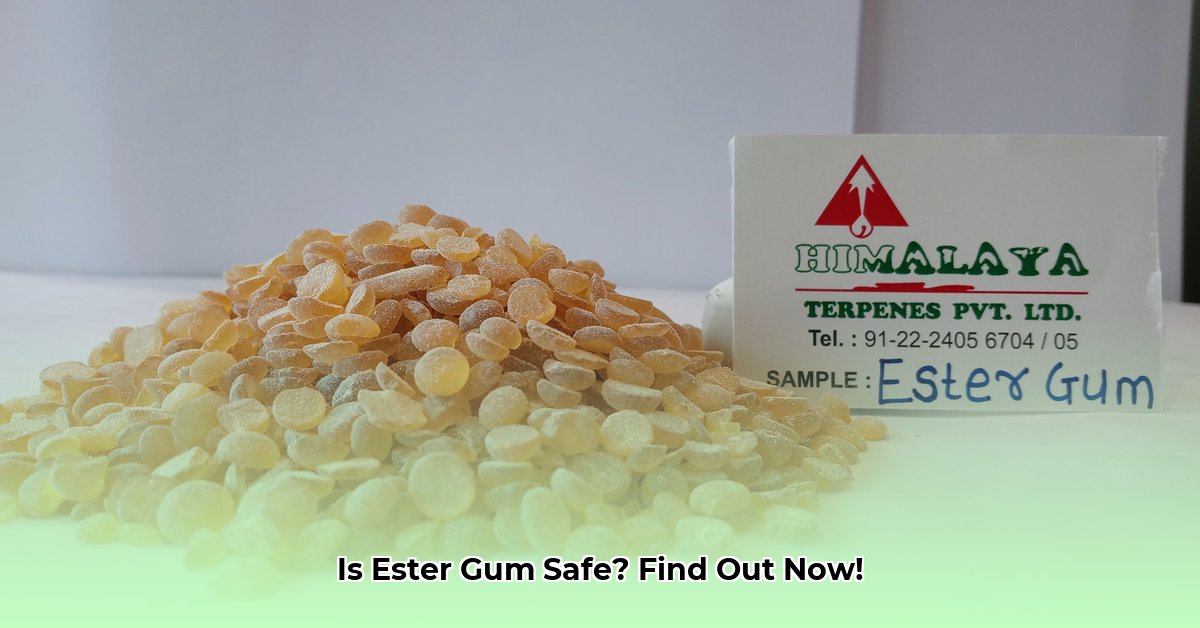Ever wonder what’s in that chewing gum or candy? Chances are, you’ve encountered ester gum, a common food additive. This review takes a close look at ester gum, exploring both its upsides and downsides. We’ll break down what it is, how it’s made, and where you find it in your food. More importantly, we’ll examine what we know (and what we *don’t* know) about its safety, discussing its regulatory status and any potential health concerns. We’ll also explore some alternatives, helping you make informed choices about the food you and your family eat. Let’s dive in and get a clearer picture of this often-overlooked ingredient.
Ester Gum: A Deep Dive into its Safety and Uses
Ester gum – what’s the deal with this ingredient popping up in so many of our favorite foods? It’s a common food additive, often used to give things a better texture, longer shelf life, and to help ingredients mix properly. But what exactly is it, and is it really safe for us to consume? Let’s take a closer look at its applications in food and potential long-term health effects.
Understanding Ester Gum: From Pine Trees to Your Pantry
Ester gum, also called glycerol ester of wood rosin (GEWR) or glyceryl abietate (E445), starts its life with pine trees. Specifically, it’s derived from wood rosin, a resin extracted from aged pine stumps or other coniferous trees. The manufacturing process involves several steps: first, the wood rosin is extracted using solvent extraction; then, it’s refined to remove impurities; finally, it’s reacted with glycerol (a type of alcohol also found naturally in fats and oils) through esterification. This chemical reaction creates ester gum. The type of pine tree species (typically Pinus palustris and Pinus elliottii) and the precise manufacturing techniques influence the final product’s characteristics. This means there isn’t just one single “ester gum”—there are variations, each with slightly different properties designed for specific purposes in different foods. The resulting product is a hard, yellow to pale amber-colored solid with low odor and taste. Did you know that the final characteristics of ester gum are heavily influenced by the manufacturing techniques involved, such as steam stripping or counter-current steam distillation?
Ester Gum in Our Food: The Multi-Tasking Additive
Ester gum is a versatile additive with several key roles in food manufacturing. Think of it as a helpful assistant that keeps things stable and prevents ingredients from separating. It acts as an emulsifier, helping mix things that don’t normally mix well, like oil and water. As a stabilizer, it helps prevent foods from becoming grainy, separating, or developing an undesirable texture over time. It also acts as a weighting agent in beverages. You’ll find it in all sorts of products:
- Beverages, especially citrus-flavored ones, where it prevents the essential oils from separating and floating to the top, ensuring even flavor distribution and preventing a cloudy appearance.
- Chewing gum, providing the right consistency, acting as a softener, and contributing to the desired chewy texture.
- Candies and confections, where it enhances texture, prevents sugar crystallization, and contributes to a desirable stickiness.
- Sauces and dressings, maintaining a smooth, creamy consistency and preventing oil separation in emulsified condiments.
- Cosmetics, where it helps stabilize essential oils and fragrances in lotions and perfumes, improving consistency and shelf life.
Is Ester Gum Safe? A Look at the Evidence
Many regulatory bodies, like the FDA (in the US), EFSA (in Europe), and JECFA (Joint FAO/WHO Expert Committee on Food Additives), have declared ester gum as “generally recognized as safe” (GRAS) or have established acceptable daily intake (ADI) levels. The FDA considers it safe based on current available evidence, and this is reassuring. The European Food Safety Authority (EFSA) set a temporary ADI of 12.5 mg/kg body weight per day for ester gum derived from Pinus palustris and Pinus elliottii due to limited reproductive and developmental toxicity data. However, it’s important to remember that “generally safe” doesn’t mean “completely and utterly without any potential issues.” We still have some questions surrounding potential ester gum toxicity and the need for further research.
While short-term studies haven’t shown any major problems, long-term data on its impact on health remains limited. More research is needed to fully understand the effects of prolonged, consistent consumption, particularly on sensitive groups like children, pregnant women, or people with pre-existing health conditions or specific sensitivities to pine-related substances. There’s also some debate about potential allergic reactions; though rare, some individuals report minor digestive discomfort, skin irritation, or respiratory issues after consuming products containing ester gum. This discomfort appears to be relatively mild in most cases and requires further investigation. Another factor to consider is the source of the glycerol used in the manufacturing process – some glycerol is plant-based, and some is animal-derived. This could be important for people following specific dietary needs and requires clearer labeling. Could increased transparency in labeling help consumers make more informed decisions?
Alternatives to Ester Gum: Other Ways to Emulsify and Stabilize
Of course, there are other ways to achieve the same results as ester gum in food. Many alternatives exist, each with its own set of pros and cons. These alternatives often perform similar functions of emulsification and stabilization. However, they may differ in cost, how they impact the final product’s taste and texture, and their own safety profiles. Some common alternatives include:
- Guar gum: A natural polysaccharide derived from guar beans, used as a thickening and stabilizing agent.
- Xanthan gum: A polysaccharide produced by bacterial fermentation, providing thickening and stabilizing properties.
- Agar-agar: A gelatinous substance derived from algae, used as a thickening, gelling, and stabilizing agent.
- Lecithin: A naturally occurring phospholipid found in soybeans and egg yolks, used as an emulsifier.
- Modified food starch: Starch that has been chemically modified to enhance its functionality as a thickening or stabilizing agent.
Choosing a suitable replacement really depends on the specific application. There is significant ongoing research and development in this area, so the field of alternatives is evolving.
The Need for More Research and Transparency
The existing safety data on ester gum offers a mixed picture. While it’s deemed generally safe by leading authorities, there continues to be a need for more research. This is particularly true regarding long-term health effects, potential allergenicity, and the frequency and severity of potential allergic reactions. Better labeling practices are also necessary. For instance, clearly indicating the glycerol source (plant-based or animal-derived) and providing more detailed information about the specific type of wood rosin used would be beneficial for consumers. This improved transparency enables more informed decisions. Only through further scientific inquiry and open communication can we fully clarify ester gum’s role in our diets and its potential long-term implications.
Regulatory Oversight and the Future of Ester Gum
Regulatory bodies are continually monitoring food additives. It’s important that these agencies continue to review and update their guidelines based on the latest scientific evidence. This approach is crucial for maintaining consumer safety and promoting responsible use of food additives throughout the food industry. Ongoing collaboration among scientists, regulators, and food manufacturers will play a vital role in strengthening safety protocols and improving communication with consumers about ester gum. What role does collaboration play in strengthening safety protocols, particularly in addressing potential risks associated with food additives?
Summary Table: Weighing the Pros and Cons of Ester Gum
| Advantages | Disadvantages |
|---|---|
| Excellent emulsifier and stabilizer | Limited long-term safety data |
| Improves product texture and shelf life | Reports of minor digestive issues in some people |
| Generally recognized as safe (GRAS) status | Uncertainty regarding the frequency of allergic reactions |
| Widely used in the food industry | Glycerol and wood rosin source not always clearly labeled |
| Alternative to brominated vegetable oil |
In summary, while currently deemed safe for consumption based on existing research, ester gum’s long-term safety profile requires further investigation. Increased transparency in labeling and ongoing research efforts are crucial steps for ensuring consumer safety and promoting informed choices in the marketplace.
What Are the Long-Term Health Effects of Consuming Ester Gum?
Key Takeaways:
- Ester gum, also known as glycerol ester of wood rosin (GEWR) or E445, is a food additive used as an emulsifier and stabilizer.
- The FDA considers it generally recognized as safe (GRAS) at typical usage levels.
- However, research on long-term effects is limited, raising questions about potential health impacts for some individuals.
- Potential concerns, though rare, may include allergic reactions and digestive discomfort for some.
- More research is needed to fully understand ester gum’s long-term effects, particularly with chronic consumption.
Understanding Ester Gum: Production and Composition
Ester gum is a resin derived from wood rosin, which comes from pine tree stumps or other coniferous trees. It’s used as an emulsifier and stabilizer in many foods. The manufacturing process involves reacting wood rosin with glycerol through esterification, resulting in a more stable and less sticky substance. Different types of ester gum exist, depending on the specific processing methods and the source of the wood rosin. This
- Bulking Lunch Recipes that Make Muscle Gain Delicious - November 12, 2025
- Simple Asian Meal Prep Recipes to Spice Up Your Week - November 11, 2025
- Simple Asian Meal Prep Ideas For Healthy And Flavorful Weekday Meals - November 10, 2025










